Deconstructing Personality Disorders and Identity Issues
Explore personality disorders and identity issues, uncovering their impact, symptoms, and paths to healing.


Understanding Personality Disorders
Definition and Prevalence
Personality disorders are mental health conditions characterized by enduring patterns of behavior, cognition, and inner experience that deviate from cultural expectations. These patterns significantly impair an individual's functioning and relationships. Signs of these disorders often emerge in late adolescence or early adulthood, with conditions persisting without appropriate treatment [1].
The lifetime prevalence of personality disorders varies across different types but ranges widely in the general population. It's critical to understand how common these disorders are to raise awareness and encourage individuals to seek help.
Personality Disorder TypeEstimated Prevalence (%)Borderline Personality Disorder (BPD)0.7 - 2.7%Antisocial Personality Disorder (ASPD)1.0 - 3.0%Narcissistic Personality Disorder0.5 - 1.0%Avoidant Personality Disorder2.0 - 5.0%Obsessive-Compulsive Personality Disorder2.1 - 7.9%
Age of Onset
The onset of personality disorders typically occurs during the teenage years or early adulthood. While the exact causes are not fully understood, it is believed that a combination of genetic factors and childhood experiences, such as trauma or abuse, plays a significant role in the development of these conditions.
Establishing personality traits begins early in life, with environmental influences shaping these characteristics. Individuals exhibiting less adaptive traits may encounter difficulties with emotional regulation, relational dynamics, and daily coping strategies.
In particular, Borderline Personality Disorder (BPD) often manifests with notable symptoms during late adolescence, with some individuals engaging in self-harming behaviors as early as 12 years old. Early detection and intervention, such as psychotherapy, can lead to better outcomes. It is essential to recognize these patterns early, as proper understanding and support can significantly improve an individual’s quality of life.
If you want to understand more about how these disorders can affect someone’s relationships or mental health, explore our articles on strategies for loved ones of individuals with personality disorders and understanding emotional dysregulation.

Symptoms and Impact
Personality disorders can have significant effects on individuals and their interactions with the world around them. Three main aspects affected by these disorders are a lack of self-awareness, relationship challenges, and daily functioning.
Lack of Self-Awareness
Individuals with personality disorders often experience a profound lack of self-awareness. They may have no insight into how their thoughts and behaviors impact their relationships Mental Health Center. This unawareness can lead to distorted perceptions, where they see their actions as normal and attribute problems to others. Such individuals may not seek help on their own, necessitating prompt intervention from family members or mental health professionals MedlinePlus.
To illustrate the awareness levels among people with personality disorders, a table detailing typical self-perception errors can be helpful:
Type of Perception ErrorDescriptionNormalizing behaviorViewing problematic thoughts or actions as acceptableBlaming othersAttributing faults to external factors instead of selfMinimizing impactUnderestimating the effects their behaviors have on others
Relationship Challenges
Relationship difficulties are a significant consequence of personality disorders. Individuals may act impulsively and struggle to understand emotions, which hampers effective interactions Mayo Clinic. Strained relationships can lead to social isolation, further exacerbating their challenges.
Several common relationship challenges encountered by individuals with personality disorders include:
Relationship ChallengeDescriptionDifficulty in communicationStruggles to express feelings or understand othersConflict escalationTendency to react strongly to minor disagreementsFear of abandonmentHeightened anxiety regarding relationships ending
For further insights on social dynamics and their implications, one can refer to social isolation in personality disorders.
Daily Functioning
Daily functioning can be severely impaired by the symptoms associated with personality disorders. Individuals in this category often fail to adopt beneficial actions for their well-being, making it hard to cope with everyday stresses. Without professional support, they may not develop the coping skills necessary for thriving in their daily lives. Studies have shown that those with personality disorders are more prone to emergency room visits, accidents, and higher incidences of suicidal behavior Cleveland Clinic.
A breakdown of areas impacted by personality disorders can include:
Area of Daily FunctioningImpactEmploymentDifficulty maintaining jobs due to interpersonal conflictsSocial interactionsLimited social circle or avoidance of social engagementsEmotional regulationChallenges managing emotions leading to distress
Understanding these symptoms is essential for individuals and their families. Professional guidance can aid in navigating the complexities of living with personality disorders and addressing issues around cognitive distortions in personality disorders or fear of abandonment.
Types of Personality Disorders
Personality disorders are categorized into three main clusters, each characterized by distinct behavioral and emotional traits. Understanding these classifications helps in recognizing the diverse ways individuals experience personality disorders and identity issues.
Cluster A Characteristics
Cluster A personality disorders are marked by eccentric and unusual thoughts and behaviors. Individuals within this cluster may exhibit characteristics such as:
These traits can lead to significant social and interpersonal difficulties, as individuals may appear odd to others and struggle with forming connections. For more information on the dynamics within these disorders, refer to the article on the role of family dynamics in personality disorders.
Cluster B Characteristics
Cluster B personality disorders are defined by dramatic, emotional, and erratic behaviors. This cluster includes:
Individuals with these disorders may experience intense emotional fluctuations and relational conflicts, which can be addressed through various coping strategies. For more on managing relational dynamics with someone exhibiting these characteristics, see our guide on strategies for loved ones of individuals with personality disorders.
Cluster C Characteristics
Cluster C personality disorders are characterized by anxious and fearful thoughts and behaviors. Key disorders in this cluster include:
Individuals with Cluster C disorders often encounter difficulties in social interactions due to their high levels of anxiety and fear. For insights into common emotional challenges faced by these individuals, read about understanding emotional dysregulation.
These classifications provide a framework for recognizing how personality disorders manifest, which is essential for both understanding and treatment. Exploring therapeutic approaches can be helpful for individuals affected by these disorders, as treatment often requires tailored strategies for effective management.
Diagnosis and Treatment
Understanding how to effectively diagnose and treat personality disorders is crucial for individuals experiencing related identity issues. This section discusses the mental health evaluation process, various psychotherapy approaches, and medication considerations.
Mental Health Evaluation
The first step in addressing personality disorders involves a comprehensive mental health evaluation. This evaluation typically includes a detailed interview, standardized assessment tools, and collaboration with healthcare professionals. Mental health professionals look for patterns of thoughts, feelings, and behaviors that align with specific personality disorders. To gather accurate information, they may also consider the individual's personal and family history.
Evaluation ComponentPurposeClinical interviewTo assess symptoms and emotional stateStandardized assessmentsTo quantify personality and psychological traitsCollaboration with familyTo gain insight into behavioral patterns and history
The importance of early diagnosis cannot be overstated. Early intervention can lead to better outcomes and a more optimistic prognosis for individuals dealing with personality disorders and identity issues.
Psychotherapy Approaches
Psychotherapy is regarded as the primary treatment for personality disorders. Various approaches have proven effective, especially for disorders like Borderline Personality Disorder (BPD). Key therapies include:
Research has shown these methods to improve the quality of life and reduce dangerous behaviors in individuals with personality disorders. Engaging in meaningful self-care and wellness activities, such as mindfulness and physical activity, can further support therapy outcomes [1].
Medication Considerations
While there are no FDA-approved medications specifically for the treatment of personality disorders, certain psychiatric medications may assist in alleviating associated symptoms such as anxiety, depression, or impulsivity. Common classes of medications that might be utilized include:
Medication TypePotential UseAntidepressantsTo treat symptoms of depressionMood stabilizersTo help regulate emotional swingsAntipsychoticsTo manage specific symptoms like agitation
In more severe cases, hospitalization may be necessary to ensure safety and provide stabilizing support. Following stabilization, individuals may be referred to day hospital programs, residential care, or outpatient treatment [5].
Treatment for personality disorders focuses on a holistic approach, integrating psychotherapy, medication, and lifestyle modifications to foster better health and well-being. For more information on strategies for loved ones, visit our page on strategies for loved ones of individuals with personality disorders.
Self-Care and Wellness Activities
Self-care and wellness activities are crucial for individuals managing personality disorders. Incorporating these activities into daily routines can enhance overall well-being and help individuals cope with the challenges associated with their conditions.
Integrating Self-Care
Individuals with personality disorders can benefit from a range of self-care practices. These may include:
Self-Care ActivityBenefitsCold ExposureEnhances resilience, improves alertnessHeat ExposureReduces stress, enhances relaxationMindfulnessIncreases self-awareness, manages emotionsPhysical ActivityReduces anxiety, boosts mood
Managing Symptoms
Managing symptoms of personality disorders requires targeted strategies to foster healthier thought and behavior patterns. Mental health professionals often play a key role in developing personalized coping strategies. Some techniques include:
Healthy Behavior Patterns
Establishing healthy behavior patterns is essential for long-term success in managing personality disorders:
Integrating these self-care practices and focusing on symptom management can significantly improve the quality of life for individuals dealing with personality disorders. Support from mental health professionals and understanding loved ones plays a vital role in this journey. For family members, learning effective strategies to support their loved ones can be crucial, as outlined in our article on strategies for loved ones of individuals with personality disorders.
Long-Term Outlook and Prognosis
The long-term outlook for individuals with personality disorders varies significantly based on several factors, treatment outcomes, and the likelihood of recurrence and recovery. Understanding these elements can aid in managing personality disorders and identity issues.
Factors Influencing Prognosis
Several factors can influence the prognosis of individuals diagnosed with personality disorders. Key contributors include:
FactorImpact on PrognosisChildhood experiencesHigher risk of developing severe symptomsTemperamental traitsDifferent responses to therapiesGenetic predispositionsVarying likelihood of persistence of symptoms
Treatment Outcomes
Treatment options for personality disorders primarily include various forms of psychotherapy. Research indicates that individuals with Borderline Personality Disorder (BPD) show improvement with treatment over time. According to studies, approximately 91% of patients achieve a minimum two-month remission, while 85% experience lasting remission for 12 months or longer [7].
Effective psychotherapy approaches include:
These methods have shown greater efficacy compared to standard treatment options. Continuous adaptation and personalization of therapy can maximize outcomes for individuals.
Recurrence and Recovery
Recovering from personality disorders often involves fluctuations in symptoms. While individuals may experience decreases in suicidal behaviors and self-harm over time, emotional regulation can take longer to stabilize. For instance, while self-harm behaviors might remit more quickly, feelings of emotional distress may persist longer [7].
Certain trends observed include:
Overall, a supportive environment, appropriate treatment, and ongoing self-care strategies can significantly enhance the prognosis for individuals coping with personality disorders. For more on managing relationships with those affected, check out our article on strategies for loved ones of individuals with personality disorders.
References
[2]:
[3]:
[4]:
[5]:
[6]:
[7]:
More Resources
A team ready to start your journey.
Get in touch — today.
We are a safe space – a haven for exceptional individuals to receive discreet, personalized, in-person treatment and care.
.avif)










